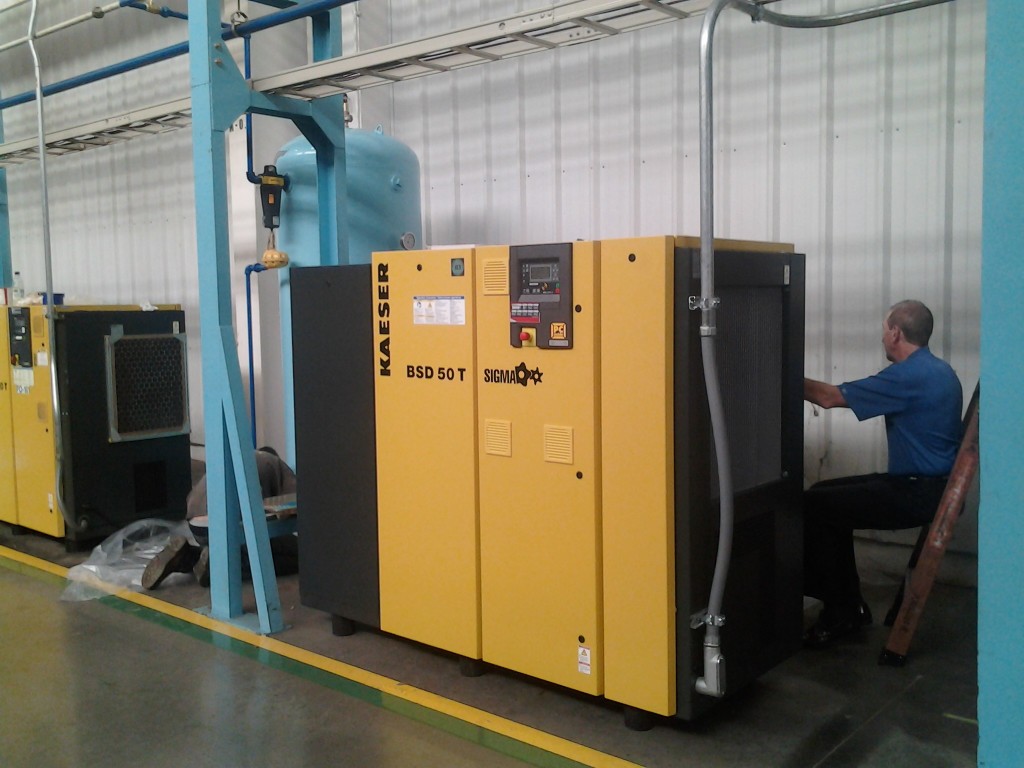October 14, 2024
Fall is the time to schedule compressors, coating and finishing, and assembly tool maintenance
Fall is a time of transition. Halloween and Thanksgiving are on the horizon. Leaves are turning shades of mustard yellow, acorn brown, and vibrant red. We’ve moved from lemonade and sandals to pumpkin spice and flannels. For manufacturing and industrial facilities, this transition time should be a reminder: schedule maintenance on all your equipment, including compressors, paint gear, and assembly tools.
Not all compressors use oil, but those that do require frequent oil changes. Like your car, oil reduces friction and keeps moving components in better shape. Check the oil regularly and replace when the oil is old or overused. Most manufacturers have specific recommendations for oil-change intervals; a user manual should describe the appropriate time for a change.
 Even the most sophisticated fastening tools require routine maintenance. Fortunately, modern tools often come with alerts, letting you know when maintenance is required. However, it’s useful to test the tool’s performance and functionality. Some of these tools can be programmed to alert engineers and technicians after a certain number of hours. In addition, some tools should receive preventive maintenance regularly. The type of tool and how often it’s used determines how often tools should be serviced.
Even the most sophisticated fastening tools require routine maintenance. Fortunately, modern tools often come with alerts, letting you know when maintenance is required. However, it’s useful to test the tool’s performance and functionality. Some of these tools can be programmed to alert engineers and technicians after a certain number of hours. In addition, some tools should receive preventive maintenance regularly. The type of tool and how often it’s used determines how often tools should be serviced.
Compressors and air system
Drain the tank
Water will steadily accumulate in an air system, especially during humid summer months when the air is (almost literally) thick with moisture. Although many advanced air systems have ways of dealing with high moisture, it still helps to drain the air tank regularly, removing moisture that could cause rust. This moisture can work into the hoses and pneumatic tools, so draining the water is critical.Tighten fasteners
Air compressors, even large industrial units, can vibrate when running. All of this vibration will cause nuts, bolts, and screws to loosen, which can eventually cause leaks and other issues. Test all of the connection and fastener points with a wrench or screwdriver, then tighten them until they are snug. Remember – don’t over-tighten, as this will damage the threading and strip the hardware.Inspect hoses
Of all the components that make your air system, the hoses are most vulnerable to wear and tear. They are coiled, stretched, twisted, bent, and dragged; internally they are subject to high pressure and rapid changes. All of this use can cause cracks and tears, which are often hard to spot. Take the time to inspect the hoses for leaks and repair or replace as needed. While you’re looking at the hoses, take a moment to inspect the connections as well.Change air filters
No matter how hard we try, dust is inevitable. To mitigate the problem, air systems are equipped with filters that capture particulates. But, like any filter, they eventually become clogged with debris and need to be cleaned or replaced. (Not all filters can be cleaned, so check with the manufacturer or consult an industrial professional.)Change the oil
Test safety components
Air compressors, especially large industrial units, have several mechanisms that prevent damage or injury. For example, there are features to prevent excessive internal pressure, which can be a threat to workers. Depending on the unit, safety components can include both mechanical and software features. Whatever features your system has, it’s best to test them regularly to ensure they are working properly.Industrial spray systems and booths
Clean tips and nozzles
Cleaning tips and nozzles are important to ensuring your spray systems continue working. You’ll probably want to clean your nozzles and tips after every major project.Clean or replace filters
A spray booth holds a variety of filters that need to be replaced. There are filters before and after compressed air enters the system, as well as filters for the paint finish that is being applied. These filters can become clogged and must be cleaned or replaced; fall is a great time to inspect and replace them.Check parts and replace
Filters are not the only parts that need to be replaced. Spray booths also have exhaust fans, air hoses, nozzles, and a variety of other features that can wear out over time. With overall use and exposure to chemicals, the booth’s efficiency can suffer.Assembly tools
Inspect functionality and schedule services
 Even the most sophisticated fastening tools require routine maintenance. Fortunately, modern tools often come with alerts, letting you know when maintenance is required. However, it’s useful to test the tool’s performance and functionality. Some of these tools can be programmed to alert engineers and technicians after a certain number of hours. In addition, some tools should receive preventive maintenance regularly. The type of tool and how often it’s used determines how often tools should be serviced.
Even the most sophisticated fastening tools require routine maintenance. Fortunately, modern tools often come with alerts, letting you know when maintenance is required. However, it’s useful to test the tool’s performance and functionality. Some of these tools can be programmed to alert engineers and technicians after a certain number of hours. In addition, some tools should receive preventive maintenance regularly. The type of tool and how often it’s used determines how often tools should be serviced.
Calibrate
Advanced tools must be calibrated to optimize performance. Calibration helps your tools meet specific industry standards, ensuring better performance, efficiency, and results.Restock spare parts
How many spare parts do you have on hand? Depending on the size of your operation, you may have dozens of inline fastening or painting tools. If these tools break down, it helps to have a full supply of spare parts so you can get back in the game quickly. Order a full supply of quality replacement parts to prolong the lifespan of your equipment while enhancing efficiency and reducing downtime.Routine maintenance for your entire system
Use late September and into October as your maintenance marker. Whether you conduct maintenance in-house or use an industrial expert, regular inspection and upkeep will ensure longer performance and high efficiency, helping you get the most from your equipment. Maintaining your system can be challenging. You already have enough on your to-do list, so let a trained and experienced professional handle all your maintenance needs! Contact us! Author: Christopher Richmann
Kif Richmann is a professional writer and editor who has been creating content since 2011. With degrees in communication and journalism from The University of Iowa, Kif has been a full-time self-employed freelancer since 2014. Throughout his career, he has served numerous industries including manufacturing, real estate, technology, finance, healthcare, transportation, and education.
Resource categories
Newsletter
Use the form below to register for our newsletter
Share
Related resources
& expert advice 
September 25, 2013
Announcing Kaeser’s re-designed BSD series rotary screw compressor
Flows from 157 – 294 cfm
Kaeser Compressors, Inc. has yet again pushed the boundaries of compressed air efficiency with the newly redesigned BSD…

December 2, 2014
7 deadly sins of compressed air
When putting together a compressed air system, temptation is all around you. You want the best system, but having the best doesn’t mean grabbing wha…

January 8, 2015
Get your compressors ready after the holidays
The holidays are over and for many plants that mean seasonal shutdowns or lower production demands are also a thing of the past. While everyone is g…
